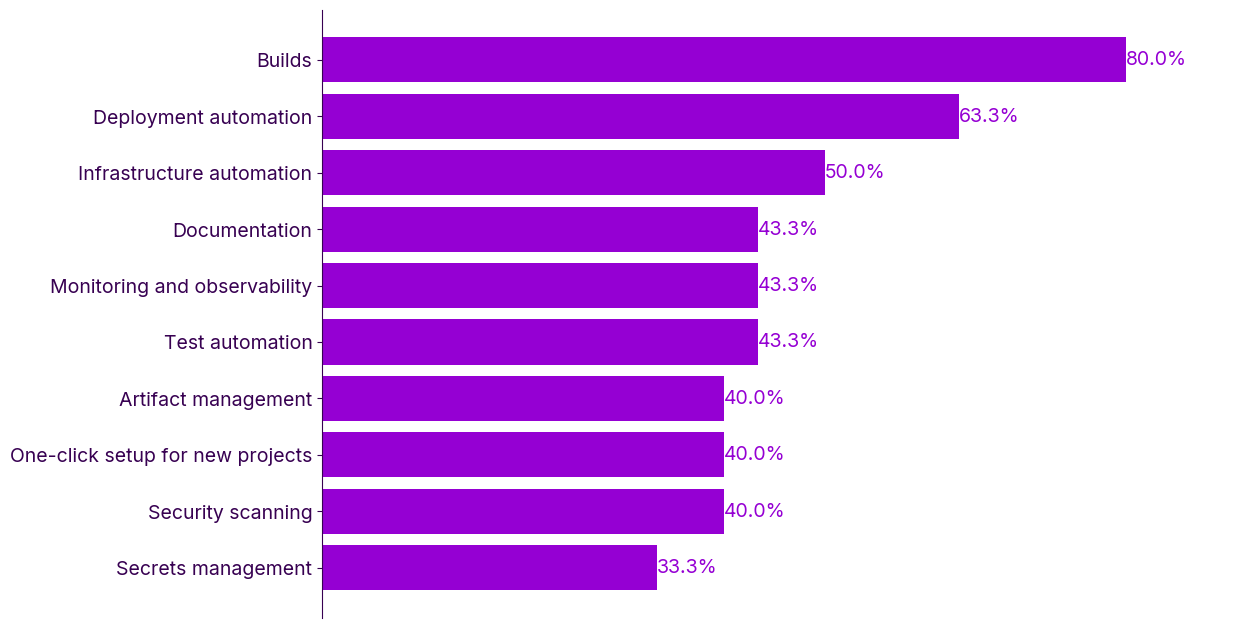Our Platform Engineering Pulse report looked at many aspects of real-world practice, but one interesting study area was the themes for common platform features. We’re launching a broader study to investigate this further, but here are the top 5 features the platform teams we asked had added to internal developer platforms.
- Build automation
- Deployment automation
- Infrastructure automation
- Test automation
- Monitoring and observability
1. Build automation
Build automation should be triggered each time you change the code and provide you with fast feedback on your changes. If you’re practicing Continuous Delivery, you’ll commit changes to the main branch every few hours, with the feedback from the build process, including fast-running tests, arriving in around 5 minutes.
The build process includes compilation, linking, and bundling. It usually consists of a suite of fast-running tests that validate the functionality and fitness of the application. In practice, this is typically a sequence of scripts or commands that run each tool in the build chain, but some build processes are more complex.
The benefit of bringing build automation into your internal developer platform is the opportunity to harmonize pipelines and bring them all up to a common standard for fast and secure builds. For example, instead of each team having to invent a way to sign their package so it can be verified later in the deployment pipeline, platform teams can make this a standard part of the build.
Development teams rarely touch their build process, compared to how much focus a platform team might put into builds. That means they are less familiar with the tools and may not be aware of features that could improve build performance or security.
2. Deployment automation
Manual deployments are one of the primary reasons for bad paths to production. Even simple manual deployments can go drastically wrong, and when they do, the organization responds by introducing process steps that slow down the flow of change. This is well-meaning, but we’ve learned that reducing deployment frequency results in larger batches, which carry more risk and cause bigger problems.
Deployment automation is the heart of change in your software delivery. When deployments are reliable, repeatable, and low-effort, you can teach the organization to do them more often. Automated deployments help you build trust and reduce heavyweight processes like change approval by committee, which universally clogs the ability to deploy small batches frequently and safely.
The steps, process templates, project templates, and policies related to deployments are a perfect fit for Platform Engineering. The platform team can ensure crucial steps are included in all deployments, like verifying the provenance of the packages being deployed and ensuring the packages and deployment process have progressed through appropriate environments before reaching production.
When the organization needs to level up security across all deployments, a platform team using the right deployment tools can quickly bring the whole organization into compliance with the new standards.
3. Infrastructure automation
There was a time when ClickOps was the default for infrastructure changes. Modern software teams have rejected the idea of managing their infrastructure by clicking around in administration consoles, cloud portals, and command lines, as the result is that no two instances of anything are the same. These differences, though sometimes subtle, can cause production incidents that are difficult to identify and resolve.
By treating infrastructure as code, the definitions can be stored in version control and follow the same review and promotion patterns developers apply to application code. When infrastructure is created and managed this way, each instance is an identical copy, and it’s easier to scale out, recover from a disaster, or create ephemeral environments for testing.
Platform teams can create standard setups for teams to use that are aligned to the technology choices in their golden pathways. Reducing the breadth of choice makes it easier to secure the infrastructure, control costs, and apply patches and updates.
4. Test automation
Sometimes it seems there are automated tests everywhere, from unit tests that run continuously in the background as a developer makes changes, to tests used in the build process, to validate end-to-end functionality, and test the fitness of the application’s performance and security. The reason for their prevalence is that testing really works.
Without test automation, your team would need to perform the same checks manually, and when you don’t do it, your customers do, which is incredibly frustrating.
While platform teams don’t typically write tests (the research shows the most effective automated tests are written by the developer creating the feature), they can provide the tools that make it easy to define tests and have them run throughout the software delivery process. Platform teams may also provide easy ways to consume test services, making it easy to spin up end-to-end tests or performance tests without managing infrastructure.
To shorten feedback loops, all types of testing should be performed continuously and ideally represented by fast, reliable test automation suites. You should cover functional, security, and performance tests within your deployment pipeline.
You should consider how test data is managed as part of your test automation strategy. The ability to set up data in a known state will help you make tests less flaky. Test automation lets developers know early if their change causes a fault, reduces team burnout, and increases software stability.
5. Monitoring and observability
While test automation covers a suite of expected scenarios, monitoring and observability help you expand your view to the entirety of your real-world software use. Monitoring implementations tend to start with resource usage metrics, but mature into measuring software from the customer and business perspective.
The ability to see information-rich logs can help you understand how faults occur so you can design a more robust system.
Other popular features
Though they didn’t make it into the top 5, documentation, security scanning, one-click setup for new projects, artifact management, and secrets management are common features of internal developer platforms.
The features are useful on their own, but when combined, they amplify their effects on overall software delivery and operational performance. Platform teams who provide a seamless toolchain from commit through to production and on to day 2 operations will find they have lifted a massive burden from developers.

What high performers do differently
The high-performing organizations used the amplification effect to provide a complete toolchain for deployment pipelines. Platforms that provided this set of functionality had more impact on the organization and its goals for Platform Engineering.
- Builds
- Test automation
- Artifact management
- Deployment automation
- Infrastructure automation
- Monitoring and observability
By creating a strong pipeline with equal consideration for long-term sustainability of the platform, you can create an offering that helps developers today and continues to help them as the organization navigates changing requirements, regulations, and competition.
We also looked at organizations with low performance; they were often missing 3 key features:
- Test automation
- Artifact management
- Monitoring and observability
If your platform is missing any of these, you may be missing an opportunity to amplify the benefits of platform adoption.
Platform success
Throughout our study, we used each organization’s individual definition of success for its platform. There are many different motivators for funding a platform initiative, and the ultimate test of a platform is whether it meets the specific goals it was founded to achieve.
You can use the MONK metrics to measure your Platform Engineering initiative. They balance benchmarkable metrics with contextual measures that track the platform’s progress against the organization’s goals.
Despite the many different ways platforms are measured, the presence of a complete feature set increased the chances of success.
Happy deployments!







